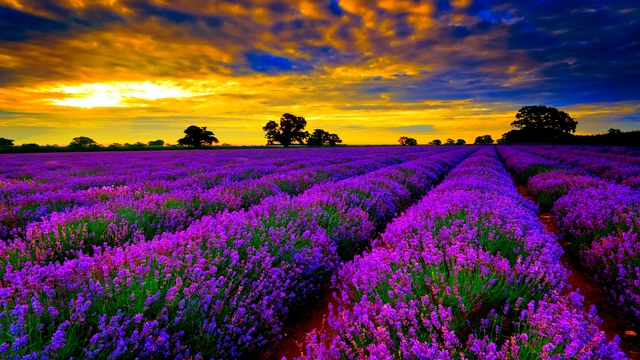 A native of the Mediterranean, lavender is used for its essential oils, cut flowers, aromatherapy and even for medicinal and culinary purposes. This popular plant is extremely easy to grow, and can provide a constant supply of fresh flowers and leaves throughout the year with very little effort.
A native of the Mediterranean, lavender is used for its essential oils, cut flowers, aromatherapy and even for medicinal and culinary purposes. This popular plant is extremely easy to grow, and can provide a constant supply of fresh flowers and leaves throughout the year with very little effort.
Planting lavender
Lavender will tolerate many growing conditions although it is best suited to sunny, dry sandy areas.
Windy areas are best avoided as this can be damaging to lavender plants. Lavender is best planted against walls, fences etc. If you are going to plant your lavender against some form of a structure, it is of high importance to ensure that the plant receives constant direct sunlight throughout the day and doesn’t get too damp in cooler months. Each lavender plant needs to be well spaced apart from both other lavender plants and other plants in general thus driving out humidity and dampness. Humid or damp areas can cause disease amongst lavender plants or even kill them. Anywhere between 50cm to 100cm is usually an appropriate distance to space between lavender plants, although small varieties of lavender may not need this much space to thrive in.
The best time to plant lavender is around mid-spring. It is best to avoid planting out young lavender plants until any danger of frost has passed. It is sometimes preferred by lavender growers (especially in cooler areas) to plant lavender in raised beds. This planting method is an excellent way to avoid the lavender plants getting soggy roots and dying out.
When transplanting lavender from pot to the ground, make sure that the plant is not placed deeper in the ground than what it is in the pot.
Suitable soil for lavender
Surprisingly, lavender tends to prefer soil of a poorer quality. Sandy, well-draining soil with plenty of organic matter is by far the best choice for growing lavender in. A PH balance of around 7 is preferred.
As many varieties of lavender have large root systems, it is usually best to turn the soil as deeply as possible before planting out lavender, thus ensuring the roots can easily stretch down into the soil. Organic matter such as compost or cow manure can be added to the soil to promote drainage and provide nutrients for the lavender plants.
Growing lavender in pots
Although lavender grown in pots will require more water that those grown in the ground, overwatering can still commonly occur. If you choose to use potting mix to plant your potted lavender in, well-draining mixture is a must.
There is no limit to the size of pot needed for lavender. Smaller pots will produce smaller lavender but will not hurt the plant in any way. If a larger plant is desired, pots from 30 to 40 litres will be needed to allow roots capable of supporting a larger plant to grow.
Basically any common varieties of lavender are well suited to growing in pots, some varieties are almost better suited to pots such as French lavender and Spanish lavender which both need to be moved out of wind and rain in cooler months to perform at their best.
Mulch
Ideally, mulch or compost should be added to the topsoil around lavender plants once a year. Mulch not only provides nutrients for plants, it can also help to avoid compacted soil.
When mulching, be sure to only ad a thin layer as over mulching can aid the soil in retaining too much moisture, in turn killing the lavender.
Pruning lavender
Pruning lavender is a great way to ensure that the plant produces fresh new shoots. Unpruned lavender plants often look woody and unhealthy, so a good prune every year or two is always needed to avoid this.
Each shoot should be cut back to around a third of its height, providing that old woody growth around the base of the plant is not affected. Spring is the best time to prune lavender as the warm weather allows the plant to make a quick recovery. Dead flower shoots can be pruned away at any time of year.
As an alternative to mass pruning, individual stalks can be cut away over time and placed in vases or used for other purposes. This practice is best avoided in winter.
Watering lavender
Lavender is extremely drought resistant and requires only minimal watering.
In-ground lavender plants usually only require a few drinks throughout summer and in most climates do not need watering in cooler months. Potted lavender will usually need to be watered fortnightly in hot summers and monthly in cooler months. If lavender plants appear to be wilted and the soil is bone dry, a good water is certainly in order.
Fertiliser for lavender
Lavender does not need to be fertilised very often. Organic fertilisers such as cow manure or complete seaweed fertiliser applied twice yearly will be more than sufficient.